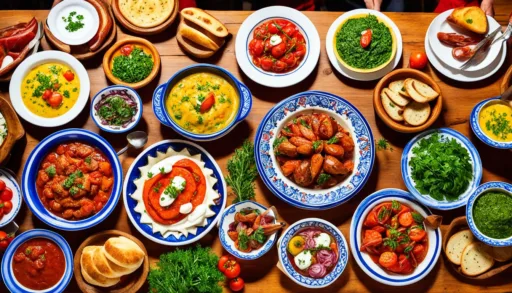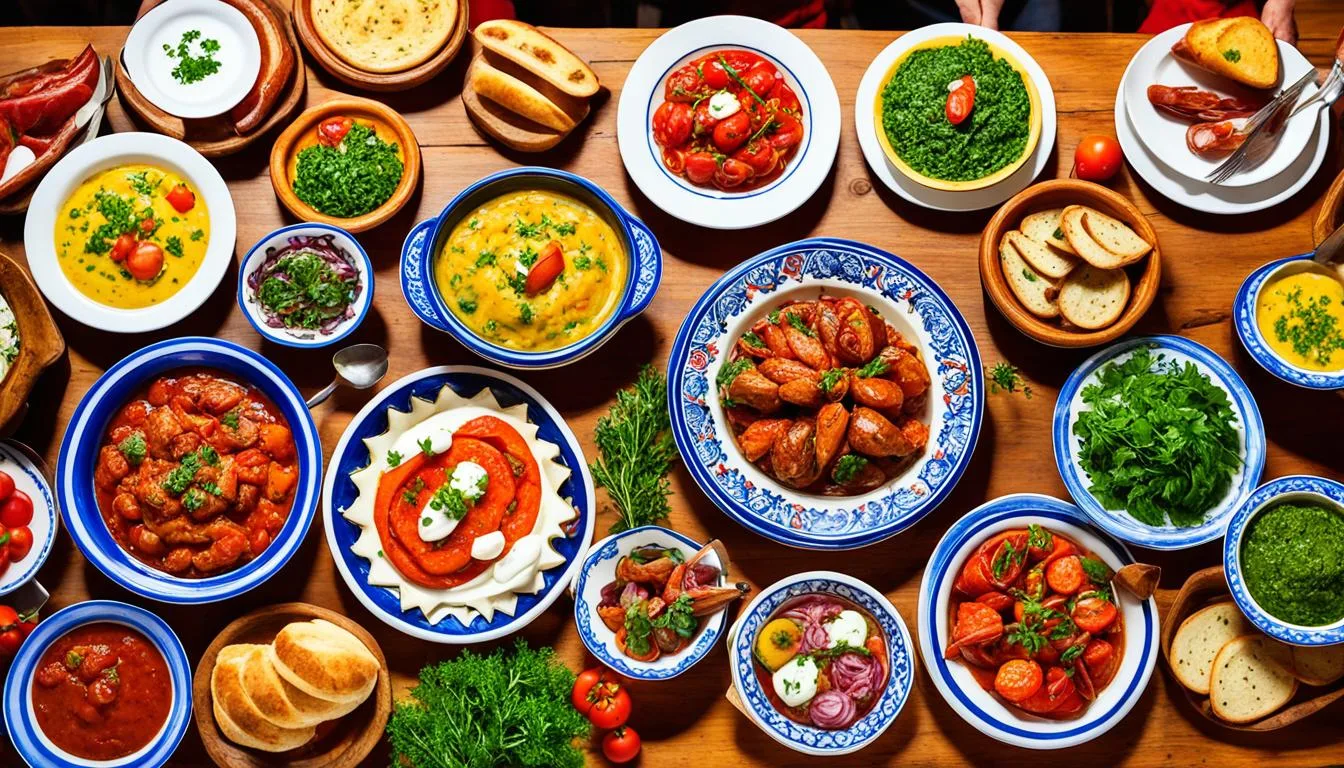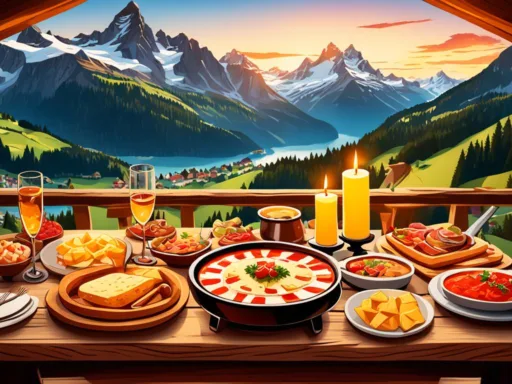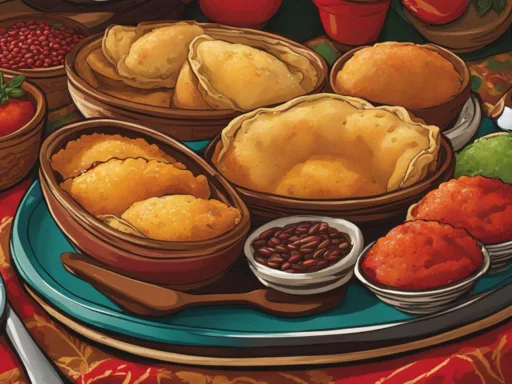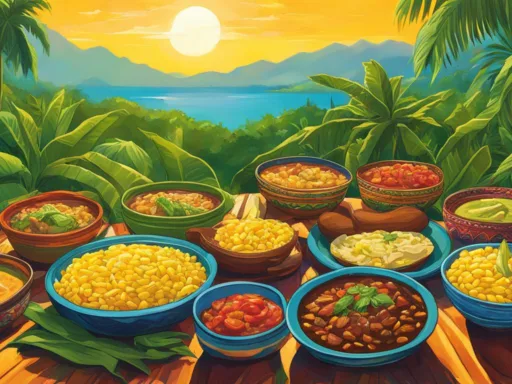When one thinks of a culinary paradise, does the hearty and soulful Serbian cuisine unfold in your mind’s palate? Unbeknownst to many, a Serbian Culinary Journey offers a treasure trove of flavors that invites the curious foodie into a world where every bite tells a story. An adventure through the diverse and rich Balkan cuisine reveals a landscape painted with traditional Serbian dishes that echo the nation’s tumultuous history, mixed cultures, and unspoiled nature. As you traverse through Serbia’s culinary customs, prepare to discover the unexpected delight of the country’s best-kept gastronomic secrets. From succulent meats to delectable pastries, Serbian cuisine is the unsung symphony of the region, resonating with the resilience of its people and the crossroads of empires past.
Key Takeaways
- Serbia’s culinary offerings are as rich and complex as its history, blending East and West on a plate.
- Traditional Serbian dishes are steeped in cultural significance, offering more than just nourishment.
- The experience of dining in Serbia is deeply tied to its natural landscape and communal traditions.
- A look into the heart of Serbian cuisine reveals an unexpected fusion of Balkan and Mediterranean flavors.
- Embarking on a Serbian Culinary Journey is an exploration of regional diversity and unity through food.
The Intersection of History and Gastronomy in Serbian Cuisine
The Serbian food culture serves as a living chronicle, chronicling centuries of historical interchange and influence through its vibrant culinary practices. As one delves into the taste of Serbia, it becomes clear that the country’s gastronomical identity is not a mere collection of recipes, but a tapestry woven with threads of past empires and trade routes. Serbian culinary traditions are a testament to the nation’s storied past, embracing the mix of peoples and their lasting impact on what is proudly served at the Serbian table today.
Unraveling the Layers of Serbia’s Culinary History
The history of Serbia is rich and varied, with each epoch contributing its distinct flavor to the country’s cuisine. Historical events have shaped the artwork on Serbian plates, enabling a gastronomical journey that reflects the resilience and adaptability of its people. Despite the myriad influences, the essence of true Serbian taste has been preserved and continues to tell the tales of its ancestors—tales of conquest, trade, and communion.
Mediterranean, Turkish, and Austro-Hungarian Fusion
Understanding Serbian cuisine necessitates an exploration of the triad of culinary influences that have left an indelible mark on its flavors. The deft blending of Mediterranean freshness, Turkish opulence, and Austro-Hungarian heartiness creates a culinary crossroads, where each dish is suffused with a historical narrative as rich and layered as the cuisine itself.
| Region | Historical Influence | Signature Dishes |
|---|---|---|
| Mediterranean | Antiquity trade, seafaring, and agriculture | Seafood, olive oil, bright herbs, zesty salads |
| Turkish | Ottoman Empire’s reign | Baklava, sarma, kebabs |
| Austro-Hungarian | Central European traditions | Goulash, strudels, creamy soups |
A Serbian Culinary Journey Through Traditional Dishes
As one embarks on a taste of Serbia, they will encounter a treasure trove of Serbian recipes that reflect the nation’s vibrant history and cultural tapestry. These recipes are not just meals; they’re a narrative of Serbia’s past, a tale of families, and a testament to the country’s spirit of unity. Sarma, cevapi, and kajmak are more than ingredients on a plate; they are stories of generations, each bite offering a connection to the roots of this rich land.
Let’s delve into a few dishes that are quintessential to the Serbian table, dishes that mirror the warmth of a Serbian household and the legacy that these foods carry. Highlighted here is a comparison of traditional dishes, beloved across Serbia, that have found their place at every significant occasion, marking the milestones of life with their comforting and familiar flavors.
| Dish | Description | Origin/Influence |
|---|---|---|
| Sarma | Savory cabbage rolls filled with minced meat and rice, cooked to perfection in a rich tomato sauce. | Ottoman influence |
| Cevapi | Grilled minced meat shaped into small sausages, often served with flatbread and onion. | Balkan tradition |
| Kajmak | A creamy dairy product akin to clotted cream, used to top bread or meats for added richness. | Native to Serbia |
| Musaka | Oven-baked casserole made with layers of ground meat and potatoes or eggplants, topped with a velvety béchamel sauce. | Mediterranean and Ottoman influence |
| Burek | Flaky pastry typically stuffed with cheese, spinach, or meat, showcasing the versatility of Serbian baking. | Turkish roots |
Every Serbian recipe tells a tale of time-honored traditions and shared experiences. These dishes not only nourish the body but also feed the soul, reinforcing the sense of identity and communal bonds through the very taste of Serbia. The table is a gathering place where stories unfold, laughter resonates, and memories are made—this is the essence of Serbian culinary life.
Serbia’s Food Culture: A Testament to Local Hospitality
Stepping into the realm of Serbian food culture reveals a world where culinary traditions are interwoven with the nation’s social fabric. Eating is not just a physiological need but a symbol of hospitality and communal bonding. Serbian households and eateries pride themselves on a shared dining experience that transcends the mere act of enjoying delicious fare.
Communal Dining: The Heart of Serbian Social Life
In Serbia, the kitchen— or ‘kuća’—turns into a vibrant gathering spot where families unite and friendships flourish. The culinary customs here reflect a society that values time spent together over meticulously prepared meals. The notion of ‘dining in Serbia’ extends beyond the flavors on the plate to the warmth of the company at the table.
Festive Foods: Celebrating Slava and Other Traditions
When it comes to festivities, such as the venerated Slava, the serenity of Serbian food culture shines the brightest. These occasions are marked by an array of special dishes, each chosen for their symbolic significance, encapsulating both reverence and celebration. Every Slava table tells a story of faith, identity, and the enduring spirit of Serbian hospitality.
By valuing the art of dining and the gathering of kin and community, Serbia maintains a culinary identity that is much more than the sum of its parts. It’s a cultural symphony played out in kitchens and ‘kafanas’ across the country, making meals in Serbia an intimate, festive, and heartwarming affair.
Decoding the Flavors: Staple Ingredients in Serbian Recipes
The vibrancy of Serbian cuisine lies in its embrace of bountiful, locally-sourced ingredients. The tapestry of flavors found in the traditional recipes is a tribute to the dynamic Serbian culinary traditions and the diverse bounty bestowed upon this rich cultural landscape.

The Use of Fresh Produce and Seasonal Vegetables
Freshness is key in Serbian kitchens, where a symphony of garden-fresh produce harmonizes to create dishes that are both flavorful and nutritive. Seasonal vegetables like tomatoes, cucumbers, and a variety of peppers play a starring role, ensuring each dish is an authentic representation of Serbia’s agrarian roots.
Meats and Cheeses: Building Blocks of Serbian Dishes
In the realm of Serbian ingredients, meats and cheeses are the pillars of strength on which many signature dishes are built. Hearty meats offer warmth and sustenance, while cheeses, such as the beloved kajmak, lend a creamy decadence that elevates the simplest of meals into culinary masterpieces.
| Ingredient | Role in Serbian Cuisine | Typical Dishes |
|---|---|---|
| Ajvar (Red Pepper Spread) | Condiment | Grilled meats, spreads |
| Kajmak (Cream Cheese) | Topping or standalone | Ćevapi, pljeskavica |
| Prebranac (Baked Beans) | Main course or side dish | Served with sausages or meats |
| Sarma (Cabbage Rolls) | Main course | Stuffed with meat and rice |
| Pljeskavica (Meat Patty) | Main course | Served with flatbreads |
In conclusion, the quintessence of Serbian gastronomy is its dedication to using Serbian ingredients that reflect its rich soil and Serbian culinary traditions. It is an enduring love affair with the land, delivering dishes that are as diverse and flavorful as Serbia itself.
From Ćevapčići to Sarma: Sampling Serbia’s Signature Dishes
Embarking on a culinary tour of Serbia offers an unforgettable Serbian dining experience, where each bite is an homage to the rich traditions and soulful past of the region. Much like a storied tapestry, traditional Serbian dishes interlace the thread of the country’s deep-rooted customs with the zest of its gastronomic innovation.
The quintessence of Serbian culinary pride can be savored in ćevapčići, a seasoned and grilled masterpiece of minced meats, ubiquitous across the Balkans yet uniquely perfected in Serbian kitchens. Likewise, sarma, the iconic stuffed cabbage roll, delivers bold flavors refined through generations of meticulous cooking techniques.
Below, explore a table that juxtaposes these Serbian delicacies, illustrating the distinct nuance each brings to the table—quite literally.
| Dish | Main Ingredients | Cooking Method | Occasion |
|---|---|---|---|
| Ćevapčići | Minced beef, lamb, pork, garlic | Grilled | Social gatherings, family events |
| Sarma | Cabbage, minced meat, rice, smoked meat | Slow-cooked | Holiday celebrations, winter meals |
In the crafting of these dishes, precision and patience are paramount, resulting in unrivaled flavors that provide a glimpse into the nation’s heart. With every morsel, diners partake in a story—where the Serbian dining experience broadens from simple sustenance to a gastronomic narrative steeped in culture and camaraderie.
- Ćevapčići urges one to indulge in the simmering street-side grills, with the scent of charred meats beckoning all who pass by.
- Sarma envelops you in the comfort of a home-kitchen, where slow simmering pots herald the arrival of cherished holidays and familial joy.
To partake in Serbia’s culinary offerings is to weave one’s palate into the very fabric of the nation’s cherished hospitality. To taste these dishes is to understand a slice of Serbia’s generous spirit and communal ethos—a delightful journey across the very soul of its culinary landscape.
Fusion of Tastes: The Influence of Neighboring Cuisines on Serbian Dishes
The culinary landscape of Serbia is a testament to the country’s rich historical tapestry, where each dish tells a story of cultural exchange and geographic proximity. Influences from Greece and Turkey, as well as Central Europe, have left an indelible mark on Serbian cuisine, crafting a gastronomic repertoire that is both varied and harmonious. Through this medley of flavors, one can trace the pathways of trade routes, migration, and shared history that have shaped Serbian culinary practices over the centuries.
Greek and Turkish Inspirations
For centuries, the empires that ruled the Balkans brought with them their culinary preferences, weaving them into the fabric of local traditions. Greek and Turkish flavors are particularly prominent, contributing a range of spices, cooking techniques, and dishes to the Serbian table. Outlined below is how these Mediterranean influences manifest in some of Serbia’s most beloved culinary offerings.
- Burek: Adopted from Turkish cuisine, this flaky pastry filled with a variety of ingredients, including cheese, spinach, or meat, is a staple in Serbian bakeries.
- Musaka: Bearing a resemblance to the Greek classic, Serbian musaka is an exquisite layering of potatoes, minced meat, and rich béchamel sauce, baked to golden perfection.
Central European Savory Soups and Stews
The robust and comforting flavors of Central European cooking have also found their way into Serbian kitchens. Here, the hearty and warming nature of soups and stews is cherished, especially during the colder months. These dishes highlight the versatility and depth of Serbian cooking techniques, incorporating locally sourced ingredients to deliver soul-satisfying meals.
| Dish | Central European Influence | Characteristics |
|---|---|---|
| Goulash | Austro-Hungarian | A rich stew of meat and vegetables, seasoned with paprika and simmered until tender. |
| Bean Soup | Czech and Slovak | A hearty bean soup often paired with smoked meats, complemented by a bouquet of herbs. |
Understanding the origins and influences that have shaped Serbian cuisine offers a window into not only the nation’s gastronomic delights but also its historical journey. Whether it’s through the flaky layers of burek or the rich broth of a goulash, each bite offers a taste of the Balkans’ culinary fusion.
Serbian Recipes: From Hearty Mains to Decadent Desserts
Embarking on a gastronomic tour of Serbia unveils a world where lush flavors from simple elements blend to present a menu brimming with character. Dining in Serbia offers not just a meal but an emblematic experience grounded in rich customs and sincere hospitality. Threading through the Serbian culinary landscape, one finds staple Serbian mains that offer sustenance and comfort, leading to the sweet embrace of quintessential Serbian desserts.
Mains That Define Serbian Dining Experience
The heartiness of Serbian mains is encapsulated in dishes traditionally served across the country. Renowned for their full-bodied taste and wholesome ingredients, these dishes are the essence of Serbian family dining and festive celebrations. The following table provides insight into the beloved mains that form the cornerstone of dining in Serbia.
| Dish Name | Main Ingredients | Flavor Notes | Occasions Served |
|---|---|---|---|
| Karađorđeva šnicla | Veal or pork, kajmak, bread crumbs | Savory with a creamy texture | Festivities, Sunday meals |
| Prebranac | White beans, onions, paprika | Rich and comforting with a hint of sweetness | Religious fasts, winter dining |
| Đuveč | Mixed vegetables, rice, meat (optional) | Herb-infused and aromatic | Family gatherings, summer meals |
| Sarma | Cabbage leaves, ground meat, rice | Tangy with a savory filling | Slava, New Year’s, winter holidays |
These Serbian mains, deeply rooted in tradition and prepared with care, showcase the nation’s affinity for dishes that warm the heart and gather people together.
The Sweet Conclusion: Serbian Desserts
Following the robust flavors of the main courses, Serbian desserts cast a delightful spell with their variety and richness. Each dessert carries a signature sweet note, harmonizing with fruits, nuts, and dairy to provide the ideal finale to any Serbian feast.
- Krofne — Airy doughnuts often filled with jam or cream, dusted with sugar.
- Vanilice — Small vanilla cookies sandwiched with jam and rolled in powdered sugar.
- Palačinke — Thin crepes served with toppings like Nutella, jam, or walnuts.
- Štrudla sa makom — Poppy seed strudel, perfect with a cup of strong Serbian coffee.
The exquisite tapestry of tastes present in Serbian desserts adds a sweet layer to the country’s culinary narrative, ensuring every meal concludes on a note as memorable as it began.
The Art of Serbian Cuisine: Advanced Techniques and Simple Pleasures
The Serbian culinary art is a vivid dance of sophistication and homeliness, captivating those who explore its breadth. In the hands of astute chefs, traditional Serbian dishes become both an ode to the sublime skills inherited throughout generations and a tribute to the unpretentious roots that ground them. It’s a world where the creamy, rich kajmak is churned with meticulous care, and the succulent pljeskavica is grilled to perfection, showcasing the Serbian dedication to both excellence and the pure enjoyment of dining.
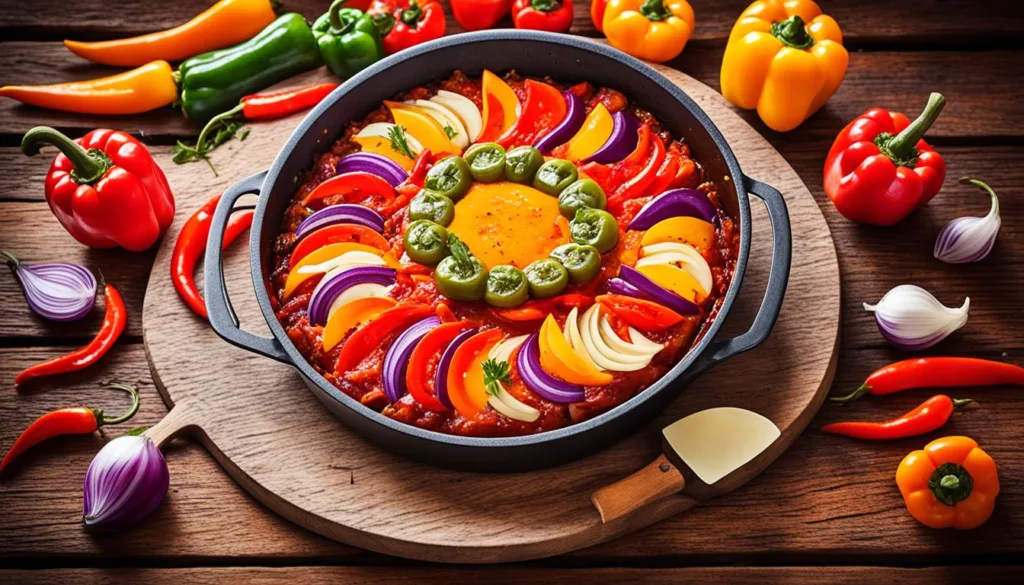
At the heart of this culinary balance lies an appreciation for the genuine flavors of the land, where each ingredient is elevated to its highest potential. For example, the artistry in Serbian bread-making, which combines the simplest of components—flour, water, yeast, and salt—into an array of breads, each with its distinct texture and taste, playing a pivotal role in both everyday meals and ceremonial occasions.
- Staple Dishes
- Sarma – Cabbage rolls filled with a blend of meats and rice
- Ćevapčići – Minced meat kebabs traditionally served with onions
- Fermentation – Employed in the making of kajmak
- Grilling – Used for preparing cevapi and pljeskavica
Through a balance of time-honored methods and the embrace of simple, fresh ingredients, the essence of Serbian cuisine transcends the ordinary, offering a culinary experience rich in history and flavor.
In recognizing the elegance of Serbian culinary presentations, we find a uniquely immersive journey into the cultural fabric of Serbia, woven with love for food that is not only meant to satiate but also to stir the soul. In the end, it’s not just the advanced techniques that set Serbian culinary artistry apart; it’s the simple pleasures, the celebration of every nuance of flavor, that truly makes traditional Serbian dishes a feast for the senses.
| Ingredient | Role in Serbian Cuisine | Preparation Technique |
|---|---|---|
| Kajmak | Condiment for meats and breads | Fermentation and churning |
| Ajvar | Spread or a side dish | Roasting and blending red peppers |
| Pljeskavica | Main course | Grilling seasoned meat patties |
Beyond the Plate: Exploring Serbia’s Food-Related Customs and Traditions
Delving into the core of what makes the culinary heritage of Serbia so distinctive, one cannot help but be drawn to the Serbian food-related customs and traditions that infuse gastronomy with heartfelt warmth and conviviality. These practices are the tapestry of Serbian hospitality, woven over centuries and passed down through generations. They go far beyond mere sustenance to represent the heartbeat of the nation’s cultural identity.
Serbian Hospitality and the Role of Rakija
When it comes to unrivaled warmth, Serbian hospitality is exemplified no greater than in the cherished custom of serving rakija. This potent fruit brandy, often homemade with an array of fruits, signifies more than just a welcoming gesture—it is a symbol of kinship and respect.
| Occasion | Rakija’s Role | Type Commonly Used |
|---|---|---|
| Welcoming Guests | Offered as a gesture of hospitality | Šljivovica (Plum Rakija) |
| Family Gatherings | Drunk in toasts to health and happiness | Lozovača (Grape Rakija) |
| Festive Celebrations | Celebratory drink to honor the occasion | Kajsijevača (Apricot Rakija) |
| Remembering Loved Ones | Served in remembrance and tribute | Dunjevača (Quince Rakija) |
The exchange and production of rakija are also entrenched in the social fabric, with many families priding themselves on their unique recipes and distillation techniques, revealing the deeply ingrained Serbian traditions around this beloved spirit.
Cultural Significance of Bread and Pastries
The cornerstone of any Serbian meal, bread, is revered not only for its essential place at the dining table but also for its profound cultural significance. In many rituals, bread is more than food; it is a powerful symbol—representing life, unity, and prosperity. One cannot talk about Serbian bread without mentioning slavski kolač, the ceremonial bread prepared for the Feast of the Patron Saint, Slava.
As the family gathers, the breaking of the slavski kolač symbolizes the strength and continuity of the familial bond—a moment that exemplifies the spirit of togetherness inherent in Serbian food culture.
Pastries, too, hold a special place in Serbian hearts, serving as a symbol of the country’s rich history and ingenuity. From sweet, flaky desserts to savory, cheese-filled delights, the pastry tradition is very much a testament to the adaptability and creativity of Serbian cuisine.
- Pita, the ultimate comfort food, varied with fillings like cheese, spinach, or meat
- Gibanica, a beloved layered cheese pie ideal for every occasion
- Krofne, airy doughnuts often enjoyed as a sweet snack or dessert
In these breads and pastries, one can taste the legacy of Serbian hospitality—a hospitality that invites friends, family, and strangers to the table, sharing in the rich tapestry of flavors and community that characterize Serbian food-related customs.
Serbia’s Culinary Regions: A Palette of Flavors
Serbian cuisine offers a smorgasbord of tastes that are deeply rooted in the diverse culinary regions of the country. Each region paints a picture of Serbia’s rich history and varied cultural tapestry, serving dishes that are as diverse as the landscapes they come from. From the hearty, spiced dishes of the south that reflect the warmth of the Serbian spirit, to the nuanced, comforting flavors of the north that whisper tales of pastoral serenity and cross-border influences, every plate promises an exploration of regional Serbian cuisine.
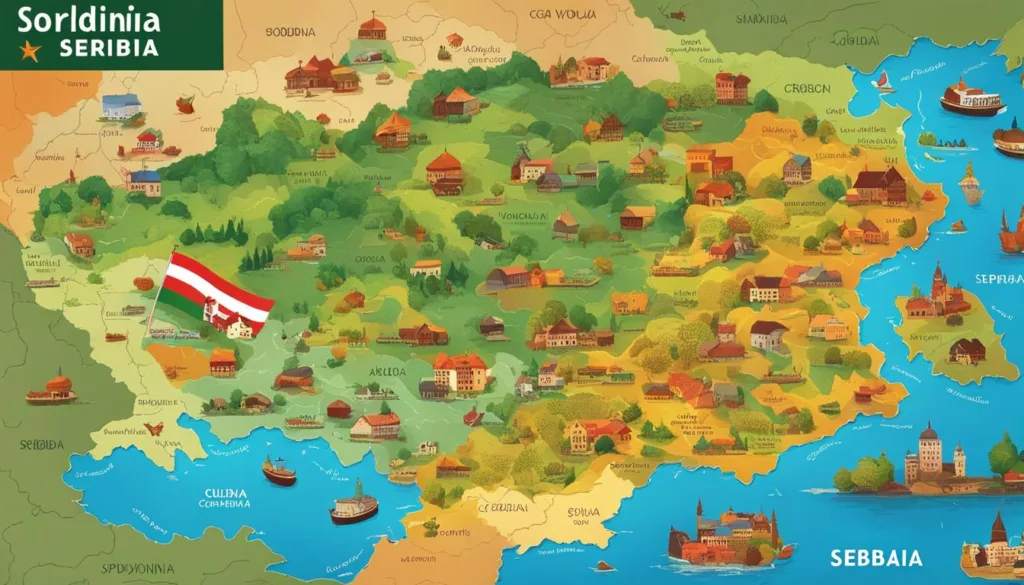
Northern Serbia: A Taste of Vojvodina
In the fertile plains of Vojvodina, flavors blend seamlessly with the heritage brought by neighboring Central European countries. Warm, welcoming stews and breads baked with love typify the region’s cuisine, evidence of a history interwoven with Hungarian, Slovak, and Austrian culinary customs. Here, the signature use of paprika and creamy dairy products are not mere ingredients but regional Serbian cuisine storytellers of communal gatherings and rich soil.
Southern Serbia: The Spice of the South
Moving towards Southern Serbia, the gastronomic narrative takes a bold turn. Spicier, vivacious dishes manifest the influence of the Ottoman Empire, creating a stimulating contrast to the northern palate. Infusing dishes with a wealth of peppers and vibrant spices, Southern Serbian recipes offer an intense profile of flavors that honor their complex history and celebrate the Serbian culinary regions in every bite.
| Region | Characteristics | Popular Dishes |
|---|---|---|
| Vojvodina (North) | Central European influences, warm stews, prominent use of paprika | Fisherman’s stew (Riblja čorba), Paprikash |
| Southern Serbia | Ottoman heritage, use of bold spices and peppers | Leskovacki cevapi, Spicy Burek with Meat |
Whether sitting down in a quaint Vojvodina tavern or a spirited Southern eatery, the dishes served are passages to understanding the historical and environmental essence of Serbian culinary regions. Regional Serbian cuisine, with each recipe and every ingredient, is a testament to the nation’s colorful past and the pride of its people.
Authentic Dining: Experiencing Serbia’s Kafana Culture
If you’re seeking an experience that truly encapsulates the spirit of Serbia’s rich cultural fabric, stepping into the warm embrace of a local Serbian kafana is essential. These vibrant hubs of social life offer much more than delectable bites; they represent the very essence of traditional Serbian dining and community.
In the realm of the kafana, every sense is indulged. From the rich aroma of freshly brewed coffee to the rustic charm of carved wooden furniture, these establishments exude a character that is at once timeless and inviting. Here, the enjoyment of a meal is transformed into an event where the food serves as a backdrop to the lively rhythms of folk music and hearty laughter that echo through the air.
Discover a place where the clinking of glasses, the hum of conversation, and the savory flavors of home-cooked meals converge to create a tapestry of gastronomic delight—a genuine slice of Serbian life.
While the menu might boast an array of light snacks, it is the experience of social connectivity that truly nourishes the soul. Engage with locals over a game of chess, share tales with travelers, or simply soak in the atmosphere where everyone is welcomed as a friend.
- The vibrant atmosphere of a neighborhood kafana: a nexus of camaraderie and music
- Sipping on rakija or enjoying a strong Serbian coffee
- Sampling traditional delicacies amidst laughter and live entertainment
No visit to Serbia is complete without delving into the kafana culture. It’s in these spaces that the true flavor of the country unfolds, with every note of music or sumptuous bite offering insight into the Serbian way of life.
Bringing Serbia to Your Kitchen: Cooking Classes and Food Tours
Serbian cuisine, a blend of robust flavors and time-honored traditions, has long been one of the gastronomic world’s best-kept secrets. Now, through the engaging formats of Serbian cooking classes and Serbian food tours, food enthusiasts have a chance to immerse themselves in the art of preparing traditional Serbian dishes. Not only do these sessions offer guidance from seasoned chefs, they also provide insights into the culinary customs of Serbia, all from the comfort of one’s own home or during an interactive journey in Serbia itself.
Immersive Experiences with Local Chefs and Experts
For those keen on diving deeper into the authentic Serbian culinary scene, opportunities abound to learn from local chefs who are passionate about their craft. In these classes, participants are not mere spectators but active learners, engaged in everything from selecting fresh ingredients to the final garnish, ensuring a hands-on experience that resonates with the vibrancy of Serbian culture.
The Joy of Making Traditional Serbian Dishes at Home
The true beauty of Serbian gastronomy unfolds in the kitchen, where recipes passed down through generations come to life. Participants of these cooking programs take with them not just the recipes, but the spirit of Serbian hospitality, making the creation of dishes like sarma or ajvar an experience to be shared with family and friends. The joy of making—and tasting—these dishes provides a delightfully delicious slice of Serbian life.
| Experience | Focus | Skills Gained |
|---|---|---|
| Serbian Cooking Classes | Hands-on preparation of traditional dishes | Cooking techniques, ingredient selection, recipe history |
| Serbian Food Tours | Cultural history and tastings | Food pairing, flavor profiling, cultural insights |
Conclusion
As we conclude our Serbian Culinary Journey, it becomes evident that the lure of Serbia’s gastronomic scene is a reflection of its abundant cultural tapestry. Serbia’s cuisine is more than just a menu; it’s a narrative that’s woven into every bite, taste, and tradition. International gourmands are increasingly drawn to the comforting embrace of Serbia’s hearty dishes, the warmth of its festive customs, and the robust history that underpins its culinary identity. The fabric of Serbia’s food culture—rich, intricate, and diverse—has created a pathway that beckons the culinary curious from every corner of the globe.
Reflecting on the Culinary Richness of Serbia
The food of Serbia is a testament to the country’s resilience and passion, a mirror reflecting the many layers of its history and the hands that have shaped its culinary art. In traversing Serbia’s landscapes, one encounters flavors incarnated from time-honored techniques, recipes passed down through generations, and the communal bond that dining extends. This journey through Serbia’s kitchens is as much an exploration of its character and heart as it is of its taste profiles.
The Growing Popularity of Serbian Cuisine Across the World
In every corner of the planet, there has been a tangible uptick in the global appreciation of Serbian cuisine. As word of its rich flavors and unique dishes continues to spread, food enthusiasts are seeking out the authentic taste of Serbia, whether in local Balkan eateries or through culinary travel experiences. Serbia’s food scene is swiftly taking its rightful place on the international stage, with its culinary treasures finding reverence amongst a broader audience. This collective recognition is a celebration of Serbia’s culture, deepening the connection between connoisseurs and the age-old gastronomic delights Serbia offers to the world.
FAQ
What notable influences can be found in Serbian cuisine?
Serbian cuisine features a fusion of Mediterranean, Turkish, and Austro-Hungarian influences, with flavors rooted in these diverse culinary traditions.
Can you name some traditional Serbian dishes to try?
Sure! Some must-try traditional Serbian dishes include sarma (cabbage rolls), ćevapčići (grilled minced meat), kajmak (a creamy dairy spread), and pljeskavica (a type of grilled patty).
How is food intertwined with social life in Serbia?
Food is a central element of Serbian social life, with communal dining being an important tradition. The local kafanas serve as social hubs where people can enjoy meals, music, and conversation together.
What ingredients are commonly used in Serbian recipes?
Serbian recipes often include high-quality meats, cheeses like kajmak, fresh produce, and seasonal vegetables, which all contribute to the rich flavors of the cuisine.
What are some influences of neighboring cuisines on Serbian dishes?
Serbian dishes incorporate Greek and Turkish inspirations, seen in pastries like burek and dishes like musaka, as well as Central European influences in soups and stews.
What is the significance of rakija in Serbian culture?
Rakija, a traditional fruit brandy, is a symbol of Serbian hospitality and often used to welcome guests and mark special occasions, showcasing the country’s warmth and conviviality.
Are there different culinary styles in different regions of Serbia?
Yes, the culinary styles in Serbia vary by region. Northern Serbia, particularly Vojvodina, has dishes with Central European influences, while Southern Serbia offers spicier flavors and more Ottoman-inspired culinary traditions.
What is a ‘kafana’ and why is it important to the Serbian dining experience?
A kafana is a traditional Serbian tavern that offers food, drinks, and often live music. It’s a cornerstone of Serbian culture, offering a window into the local community life and traditional dining.
Can visitors take cooking classes or go on food tours in Serbia?
Yes, visitors can partake in cooking classes and food tours to learn about and experience authentic Serbian culinary practices. These activities provide a deeper connection with Serbia’s food culture.
Why is Serbian cuisine gaining popularity globally?
Serbian cuisine is gaining global recognition due to its rich heritage, depth of flavors, and the unique blend of cultural influences that provide an enticing gastronomic experience.
